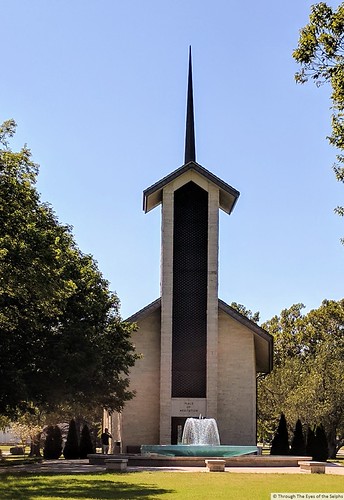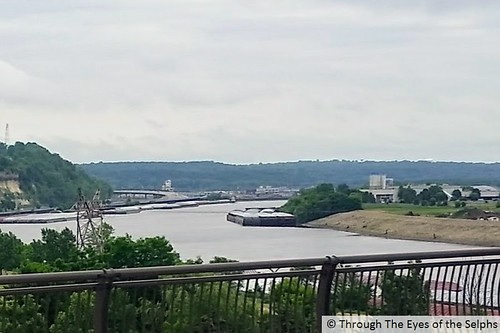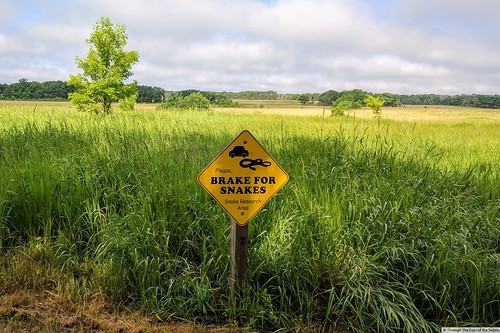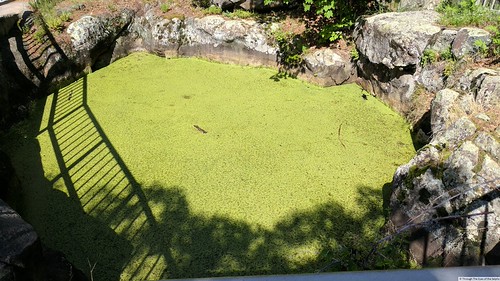From Topeka we headed west to Milford Lake State Park in Milford, Kansas. Milford Lake is the largest lake in Kansas made from the 16,000 acre Milford Reservoir, the largest reservoir in Kansas. 
One day we made the short drive to Abilene to visit the Dwight D. Eisenhower Presidential Library, Museum and Boyhood Home.
Eisenhower is the 34th President and the only five star general to ever be elected President.

Located on a twenty-two acre site, the Eisenhower Presidential Library and Museum is made up of five buildings all within close walking distance. Within the site:
- twenty-six million pages of historical records and papers
- 335,000 still photographs
- 768,000 feet of original motion picture film
- 70,000 artifacts
 First we stopped by the Visitors Center and saw a twenty-five minute film on his life. Next we visited his boyhood home. Even though he was born in Denison, Texas in 1890, he always considered Abilene his hometown since his family moved there when he was a year and a half old. He was one of seven sons. All the boys were called “Ike”, an abbreviation of their last name. By World War II, only Dwight still used the nickname.
First we stopped by the Visitors Center and saw a twenty-five minute film on his life. Next we visited his boyhood home. Even though he was born in Denison, Texas in 1890, he always considered Abilene his hometown since his family moved there when he was a year and a half old. He was one of seven sons. All the boys were called “Ike”, an abbreviation of their last name. By World War II, only Dwight still used the nickname.
In the parlor of his boyhood home sits the radio the Eisenhower boys bought their mother so she could keep up with the news of the war. 
The Boyhood Home was opened to the public in 1947. The Eisenhower family lived here from 1898 until his mother died in 1946. His parents were deeply religious and belonged to the River Brethren, a Mennonite sect with Dutch Pennsylvania origins. The family often spent time reading aloud from the Bible. His mother was a pacifist who was very saddened to learn Dwight wanted to enter the military. Growing up on the farm in Abilene his parents taught Ike humility, the value of hard work, respect for learning, discipline and spiritual devotion. Dwight’s mother sometimes had to take history books away from him so he would pay attention to his other subjects in school. 
His childhood heroes were Hannibal, George Washington and Robert E. Lee. In 1909 the high school yearbook predicted that Dwight would become a history professor at Yale and his brother Edgar would be President of the United States. Both his parents attended a small college and four of the sons graduated from college. Every President since Eisenhower has had a college education.
Next we visited the museum, dedicated in 1954. This museum was noticeably different from the previous Presidential museums we have visited. Ten percent was dedicated to cowboy and pioneer life in old Abilene (Chisholm Trail), fifty-five percent to World War II and his military career and about thirty-five percent to his personal life and Presidency. It is one of the very few Presidential Library and Museums we have been to without a replica of the Oval Office.

Abilene was originally founded in 1856 and called Mud Creek, the town was renamed Abilene in 1860 after a Bible passage in the Book of Luke. The American style cowboy boot is believed to have started in Abilene when bootmaker Thomas C. McInerny made a pointed toe boot with a high heel that would stay in the saddle. It replaced the Confederate Cavalry boot. McInerny advertised his boots in the late 1860’s, probably making his shop the first to produce the modern cowboy boot in America. At one point McInerny employed fifteen men in his shop.
Eisenhower enjoyed reading westerns and watching western TV shows and movies. He loved receiving western theme gifts. On display is a pair of cowboy boots specially made for him. Notice the capitol building on them. He was a cattleman on his farm in Gettysburg, Pennsylvania where he raised Angus cattle (see our previous post of October 1, 2016).
Eisenhower accomplishments:
- Graduate of the United States Military Academy and a professional soldier. Actually he had wanted to attend the Naval Academy at Annapolis, Maryland but at age twenty was too young to enlist there.
- At the Military Academy he was more interested in sports than academics. His final class standing was 61st in grades and 125th in demerits.

- Served as Commander-in-Chief of Allied Forces in Europe during WWII



- Military governor of the American zone of occupation in Germany
- Chief of Staff of the U.S. Army
- Supreme Commander of NATO
- President of Columbia University
- 34th President of the United States. He was the first Republican president since Herbert Hoover left office in 1933.

- He began his presidential address with a prayer which is mounted on the wall of the chapel where he is buried.

- Initiated the country’s first civil rights legislation since post-Civil War Reconstruction
- Ordered U.S. Army troops to enforce the integration of Central High School in Little Rock, Arkansas, a highly controversial decision

- Construction of the Interstate Highway System which contributed to economic expansion and improved daily lives of Americans



- His diplomacy kept the “Cold War” cold.
- Under Eisenhower’s administration the North Korean and Chinese believed nuclear weapons would be used if necessary. The two Koreas signed a truce agreement in 1953.
- Between 1955 and 1961 the U.S. provided over $1 billion in weapons, financial aid and advisors to the South Vietnamese government, but no military troops.
- During the Geneva Summit Eisenhower met with leaders of Great Britain, France and the Soviet Union. The “Spirit of Geneva” that resulted in the meeting provided hope that a post-Stalin Russia would be less hostile to the United States.
- President Eisenhower recognized Castro’s threat in Cuba and approved a covert plan to replace the Castro regime. His plan continued after he left office.
- Created Department of Health, Education and Welfare which Congress had refused under Roosevelt and Truman. Through HEW, he extended Social Security benefits to previously ineligible retirees. He pushed vocational rehabilitation to provide assistance to physically disabled people and also increased the minimum wage by 33 percent.
- Instituted the National Defense Education Act authorizing $1 billion in loans and grants over seven years for college students majoring in science, math or foreign languages. This was in response to Russia’s launching of Sputnik.
- Supported nationwide distribution of the polio vaccine and appropriated $28 million to inoculate those who could not afford it.
- Convinced Congress to accept a larger public housing program because of a decline in urban cities due to middle class movement to the suburbs, leaving behind mostly poor, black Americans.
- In response to Sputnik and at Eisenhower’s urging, Congress passed the National Aeronautics and Space Act in July, 1958, creating NASA.

- Today many people view the technology revolution and breakthrough in satellites, atomic energy and jet airliners to be one of the most lasting accomplishments of the Eisenhower presidency. He approved the development of reconnaissance aircraft and satellites to provide better technical information about Soviet military efforts.

Eisenhower suffered a serious heart attack in 1955 but agreed to run for a second term in 1956. He won re-election against Adlai Stevenson by the largest landslide in history, carrying 41 out of 48 states. He suffered a stroke in 1957 that left his speech slightly impaired from then on.




The end of the Eisenhower presidency and the beginning of Kennedy’s signified the end of one era and the beginning of another in many ways. Eisenhower was the last president born in the nineteenth century, Kennedy the first born in the twentieth. At that time Eisenhower was the oldest man ever elected president, Kennedy the youngest. Leaders around the world knew Eisenhower from his leadership roles for over twenty years. Many foreign heads of state barely knew Kennedy.
Eisenhower once wrote that he admired above all others three presidents – Washington, Lincoln and Theodore Roosevelt.
Interestingly, a ranking of presidents in 1965 placed Eisenhower well below average. Over the years as more became known about his presidency, by the year 2000, he was ranked in the top ten. As part of C-SPAN’s third Historians Survey of Presidential Leadership in 2017, almost 100 historians and biographers rated him as fifth best President.
We finished our visit by stopping by the Place of Meditation, a chapel where President Eisenhower, Mamie and their son Doud are buried. Doud died at the age of three of scarlet fever. Eisenhower said his son’s death was “the greatest disappointment and disaster in my life”.

Eisenhower passed away in 1969 and was brought home to Abilene where he was buried in a regulation U.S. army casket.
I think you can learn a lot by reading a person’s quotes, or what others say about him.
Quotes by and about Eisenhower:
- “The final battle against intolerance is to be fought – not in the chambers of any legislature – but in the hearts of men”. Campaign speech, 1956
- “Always try to associate yourself closely with and learn as much as you can from those who know more than you, who do better than you, who see more clearly than you. Apart from the rewards of friendship, the association might pay off at some unforeseen time – that is only an accidental byproduct. The important thing is that the learning will make you a better person”.
- “Desire may sometimes have to give way to a conviction of duty”. (Eisenhower was reluctant to run for president, calling the idea absurd. In 1945 President Truman told Eisenhower he would support him for President in 1948, even joking he would agree to be Vice-President. In 1952 when leading Republican candidate Senator Robert A. Taft refused to support the United States providing troops to NATO, Eisenhower agreed to run. By 1952, an estimated eighteen million American homes owned a television set, making it the first televised campaign.


- “God help the nation when it has a President who doesn’t know as much about the military as I do.”
- “Ike could be reelected even if dead.” columnist Walter Lippmann on Eisenhower’s possible third term as president even though he was constitutionally prevented from running for a third term. Eisenhower had an average approval rating of 64%.
- “My principal political disappointment was the defeat of Dick Nixon in 1960.”
- “There is no victory in any war, except through our imagination, through our dedication, and through our work to avoid it.”
- “One of my major regrets is that as we left the White House I had to admit to little success in making progress in global disarmament or in reducing the bitterness of the East-West struggle. But though, in this, I suffered my greatest disappointment, it has not destroyed my faith that in the next generation, the next century, the next millennium, these things will come to pass.”
- “If all that Americans want is security, they can go to prison.”
- “I wish to say a word directly to our young people. It will soon be your country to run, and you should be interested and personally involved.”
- “America will be a lonely land without him. But America will always be a better nation – stronger, safer, more conscious of its heritage, more certain of its destiny – because Ike was with us when America needed him.” Lyndon Baines Johnson
- “He was a general who truly hated war, but who hated the Nazis more. He was the President who made a peace and kept the peace and this provided the conditions that made it possible for the American people to exercise their rights to pursue happiness.” Stephen E. Ambrose

































































































































































































































